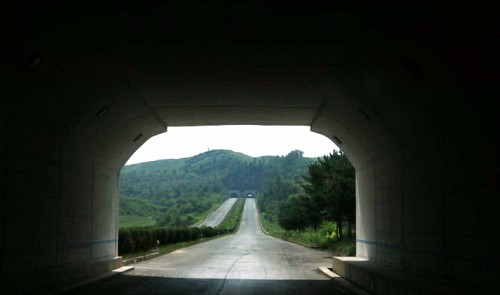Pyongyang, the capital of the Democratic People's Republic of Korea, or North Korea, boasts lavish edifices which tip-toe the line of extreme wastefulness.
Passing the Arch of Reunification, a sculptural arch located south of Pyongyang, the Reunification Highway leads south with six traffic lanes and a median strip which boasts lush, neatly pruned decorative plants in between.
No sooner had a group of Tuoi Tre (Youth) newspaper reporters and their companions on a recent tour of North Korea begun marveling at the lavish, spacious road in the capital, infrastructure one would expect in a developed Western country, than the road turned intolerably bumpy.
Sections of the highway are riddled with potholes and patches, forcing the bus into a snail-like pace of 70 km/h, despite being one of the few vehicles on the road.
The completely straight road has no intersections. Instead, it uses flyovers and tunnels to direct traffic from horizontally running roads below or above the highway and right-turn lanes to allow traffic to enter and exit the highway.
Choe Un Mi, the group’s tour guide, explained that the highway opened in 1999 as a link between Pyongyang and Kaesong, a city in North Hwanghae Province in the southern part of North Korea.
The twist-free street is not flanked by residential areas and cities in Hwanghae-pukto Province including Chunghwa, Kangnam, and Sangwon can only be spotted from afar.
The nearly-170 km road has a surprisingly large number of trespasser tunnels, all of which have twin openings and several of which span four to five kilometers through complete darkness.
The Tuoi Tre reporters observed that the highway could have been planned slightly differently in order to avoid the need for tunnels, yet the designer chose to do it the hard way.
There are at least five consecutive tunnels on the last 50 kilometers of the street and the entrance of each shaft is visible from the one before.
The entrance to the third tunnel is even visible from the first.
‘Don’t mention costs!’
Tour guide Choe explained that the street has around 40 of these twin tunnels, all of which serve to ease travel by eliminating any slopes in the road’s path.
“Don’t mention costs in our country. Where there is a will, there is a way,” she said in reply to the reporters’ comment on the wastefulness of building so many tunnels.
The following day the group was guided to Bohyeon, a time-honored Buddhist temple located in Hyangsan County in North Pyong'an Province, approximately 100 km from the capital.
The road leading to the temple also has six lanes and is free from intersections and turns, but instead of using tunnels to force a straight path this road is famous for bridges, a feature typical of roads leading to the northern region of the country.
While most countries prefer to dig into mountains to build meandering highways, North Korea prefers to construct these overpasses which span dozens of kilometers.
These three-lane overpasses lean against mountains on one end and cross rivers on the other, stretching as far as the eye can see.
Built in the 1990s, the bridge-riddled street mentioned sees very limited traffic, giving the highway the timeworn, dilapidated look of disuse, not overload.
Coupled with unnecessary and expensive highway designs, the overly grandeur edifices and structures dotting North Korean cities and towns gave the Tuoi Tre reporters a mixed feeling of extravagance and wastefulness.
Buildings like the 150,000-seat May Day Stadium, one of the world’s largest, a 20,000-seat indoor stadium, sports centers, water parks, theaters, and the lavish skyscrapers lining North Korea’s spacious, linear streets were a spotlight on the country’s indulgence in lavish and unnecessary infrastructure.
While most were meant to become imposing highlights, their usage capacity remains unknown.
One of North Korea’s most striking symbols is Ryugyong Hotel, situated on Potong Bridge Street in Potonggang District.
The 105-floor hotel towers at a height of 330 meters, making it the most prominent feature of Pyongyang's skyline, the tallest structure in North Korea, and a member of the world’s 50 tallest skyscrapers.
Construction on the hotel began in 1987 but was halted in 1992.
After 1992 the building’s skeleton had been completed, windows and interior fittings were left unfitted until 2008 when construction resumed. The building’s exterior was finally completed in 2011.
The hotel was meant to open in 2012, the centenary of revered leader Kim Il-sung's birth, but as of 2016 the pyramid-shaped building with the ballpoint-pen top remains off limits to the public, despite decades of construction and cost estimates of hundreds of millions of dollars.
A diplomat revealed in 2008 that the exterior glass was applied to the unfinished skyscraper to cover the unsightly construction work inside.
The entire investment was made by Egypt’s Orascom Telecom Co. in exchange for a monopoly on the trading rights to mobile networks across North Korea within four to five years.
According to Professor and Architect Nguyen Quoc Thong, deputy chair of the Vietnam Architects Association, who took a working trip to North Korea in August this year, the country’s imposing edifices were built in its ‘heyday’ during the 1980s and basically conform to the design and structuring principles adopted by the rest of the world.
The new structures, however, reflect “the country leaders’ mindset and decisions.”
“These buildings hardly abide by world construction criteria and lack unity between their design and usage,” Thong said.
“The sleek sci-tech complex is indicative of the clash between aspirations for mammoth edifices and state-of-the-art technological applications. Few countries do the same and the trend is quite perilous,” the seasoned architect remarked on Ssuk Islet, an atom-shaped science and technology center in Pyongyang’s Taedong River.























































